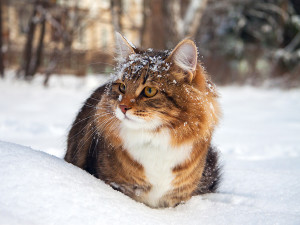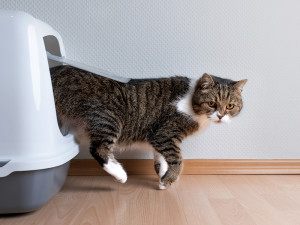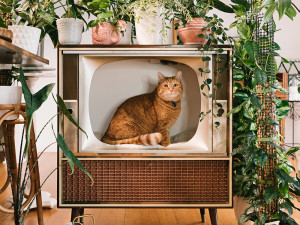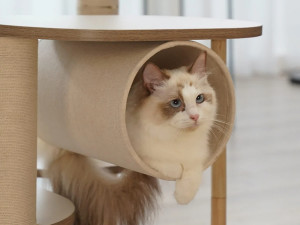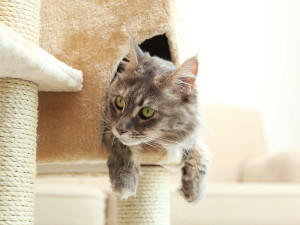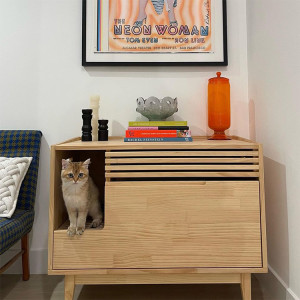How to Make an Outdoor Cat House for Winter
Channel your inner HGTV star and build a feline fixer-upper.
In This Article:
How Cold Is Too Cold for Cats? How to Keep Outside Cats Warm How to Build an Outdoor Cat House What Should I Put in an Outdoor Cat House?
Calling all DIY enthusiasts, animal lovers, and anyone who is generally bored during the winter months (aren’t we all, though?): It’s time to put those crafty skills to use and do your neighbor cats a solid.
Harsh temperatures and unpredictable elements are on their way, if not already here, and our fellow outdoor felines need safe shelter to protect those toe beans from frostbite. If you don’t know how to make an outdoor cat house for winter, fear not — we have all the tips and tricks you need to construct a cozy haven for any cat who needs respite from the chilly whims of Mother Nature.
Save on the litter with color-changing tech that helps you better care for your cat.
When building a winter cat shelter, you’ll want to use durable materials, advanced insulation solutions, and clever features to ensure top-notch safety. Add some food and water and voilà, you’re not only a hero to your local cats, but you’re one step closer to getting your own HGTV show. So put on your tool belt, and let’s get into the nitty gritty.
How much do you spend on your pet per year?
How cold is too cold for cats?
Outdoor cats can withstand some pretty brutal conditions, so you may think that a little chill is no biggie. But the reality is, just below freezing temperatures can be very dangerous.
“It is generally recognized that when temperatures dip below 32 degrees, cats can be in serious danger,” says Dr. Ray Spragley, founder and veterinarian at Zen Dog Veterinary Careopens in new tab. “Even temperatures in the 40 degree range can start to lead to issues. Below freezing, it is possible for cats to initially develop frostbite, and eventually, hypothermia.”
Dr. Spragley explains that cats have a normal body temperature of 100 degrees on average. If they become hypothermic, their body temperature drops below 90 degrees, which leads to central nervous system depression, weakening of muscles, decreased heart rate, and shallow breathing. If they don’t receive treatment, it can become fatal.
Having a warm place to go during the winter months will do wonders for their health and safety. And in case you didn’t already know, you should never let a domestic cat live outdoorsopens in new tab due to the high risk of disease, injury, and death. This outdoor cat house project only applies to feral and wild cats that already live outdoors. If you want to DIY something for your indoor cat, try a catio — your cat will thank us later.
How to keep outdoor cats warm
Your first instinct may be to invite these wild animals inside Snow White-style so you can stay warm and cozy together. But according to Dr. Jessica Love, veterinarian and medical director at Angel Paws Veterinary Servicesopens in new tab, that’s not a good idea.
“The unfortunate reality is that even if there is a temperature that is ‘too cold’ for outdoor cats, feral cats are wild and will not live indoors,” Dr. Love explains. “Even if they are trapped, they do not thrive in an indoor environment. The best way to help them is to provide adequate outdoor shelter and to prevent them from breeding. Sterilization helps to reduce their numbers and also reduces the demand for calories in their bodies.”
Dr. Love recommends reading up on Trap-Neuter-Return (TNR), a process involving safely trapping, spaying or neutering, and returning feral cats to their environment. This helps reduce the feral cat population and improves their overall well-being. When it comes to staying warm, Dr. Love explains that while it’s true that outdoor free-roaming cats grow a thicker coat of fur during winter, they still need protection from the cold weather.
Here are some things you can do to help keep outdoor cats warm:
Build an outdoor cat shelter with durable materials.
Elevate the shelter to keep it from touching the wet ground.
Insulate it with straw or pillowcases filled with packing peanuts and shredded newspaper.
Consider adding a heat-reflecting material for extra cold nights.
Clear snow and ice around your yard.
Provide food and fresh water.
Check in regularly to ensure your winter cat shelter is in good shape.
How to build a DIY outdoor cat house
It’s time to put your knowledge to use and start building. Here’s everything you need to do to construct a safe and effective DIY outdoor cat house.
1. Choose your outdoor cat house type.
There are dozens of ways to build an outdoor cat house that will adequately keep local felines warm. Plastic, wood, and even styrofoam are all good options. Dr. Love recommends building a cat house using large disposable coolers.
“These are the types of foam coolers that veterinarians receive their vaccines in, for example, because they are extra thick and are perfect for providing protection and keeping cats warm in winter,” Dr. Love says. “Similar coolers may be available from fish markets, medical centers, and even grocery stores, where the staff may be happy to donate them. Because they are disposable, people tend to be glad to see them reused and recycled for a good cause.”
Another popular option is using an old plastic storage bin. We’d venture to guess that there are probably at least three of those sitting in your attic filled with unnecessary things from high school (ahem, you actually don’t need that old dried up corsage from prom). Empty one of those out, and put it to good use this winter.
2. Acquire the necessary materials.
Once you’ve decided what you’ll make the house out of, you also need to gather the materials for what will go inside. If you’re heading to the store, at the very least, put these materials on your list:
A cooler or plastic storage bin
Plastic wrap
Straw
Other items you can use include pillowcases, packing peanuts, shredded newspaper, and Mylar. If you don’t have two extra bowls for food and water, put those on your list, too.
3. Decide on placement.
The placement of your shelter is key to ensure that the cats use it and are protected from the elements as much as possible. “Place the shelter near brush or other areas that the cats normally inhabit,” Dr. Love recommends. “They will be less likely to use a shelter in an open area.”
She also suggests placing the shelter on a pallet, bricks, or even straw to help insulate it from the ground. This will keep it drier and reduce the likelihood of needing repairs.
4. Build the house.
The good thing with the cooler or bin option is you’re not “building” much of anything — you’re just making tweaks here and there to make sure it’s effective. First, you’ll want to wrap the cooler or bin in plastic and tape it securely. This will keep out moisture and help cats stay warm and dry. Then, you’ll want to cut an entry hole near the top of one wall, which prevents water and snow from entering the shelter.
“The hole should be between five and a half to six inches in diameter, which is usually the right size to allow the cat to enter while not allowing too much heat to escape,” Dr. Love says.
5. Insulate the house.
Now it’s time to kick the cozy factor up a notch. Dr. Love recommends straw bedding because it repels moisture and won’t get wet and freeze like blankets or towels. This also allows cats to burrow inside.
If you can’t find straw, pillowcases filled with packing peanuts or shredded newspaper will also work. Place your insulation material of choice inside. Pro tip: Forego blankets, towels, or folded newspaper here. These will actually absorb body heat and make cats chillier.
6. Accessorize the space.
When we say “accessorize,” we don’t mean hanging pictures or adding decorative pillows to your winter cat house, although that would be really fun. This is when you’ll want to consider additional heat-reflecting materials for those extra chilly evenings. Some DIYers like to add Mylar to the interior walls to keep it even warmer.
This material acts as a reflective barrier, helping to retain the heat generated inside the shelter. Dr. Love says you should also put food and water bowls nearby, because cats need extra calories to stay warm when it gets cold. “It’s helpful to build an elevated feeding station to keep the food and water off the frozen ground,” Dr. Love says.
7. Maintain the house.
Once your DIY winter cat house is built, you can mostly sit back and relax. However, you should regularly check in and replace any wet items, make needed repairs, and refill food and water bowls.
If you can do this, you’ll have given outdoor cats a much better chance at survival during what is often a cold and bleak winter for them. Hey, you never know, if you crush this project, your knack for feline architecture might lead to some well-deserved fame.
FAQs (People also ask):
What is the best bedding for outdoor cat houses?
Straw is the best bedding for outdoor cat houses. This material provides excellent insulation and helps retain warmth, making it an ideal choice for creating a cozy and comfortable environment for outdoor cats. Unlike other materials, straw doesn’t retain moisture, reducing the risk of mold and ensuring a dry and insulated space. Straw is also cost-effective, readily available, and easy to replace when needed.
Do cats get cold easily?
Yes, cats get cold relatively easily, just like humans. While their fur provides some natural insulation, they can feel cold if exposed to harsh weather conditions, particularly during extreme cold spells. Certain factors such as age, health, and the severity of the cold weather can impact a cat's tolerance to low temperatures.
Can cats survive in the cold?
Cats can survive in the cold in certain temperatures, but temperatures below 32 degrees Fahrenheit can pose risks to their health and well-being. It’s crucial to provide them with adequate shelter, food, and fresh water to keep them warm during the winter months.
References:
Uncontrolled Outdoor Access for Cats: An Assessment of Risks and Benefitsopens in new tab


